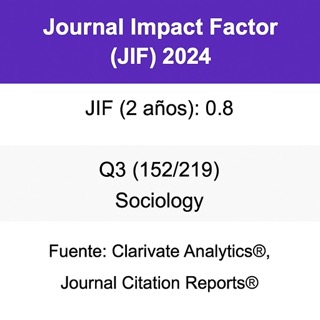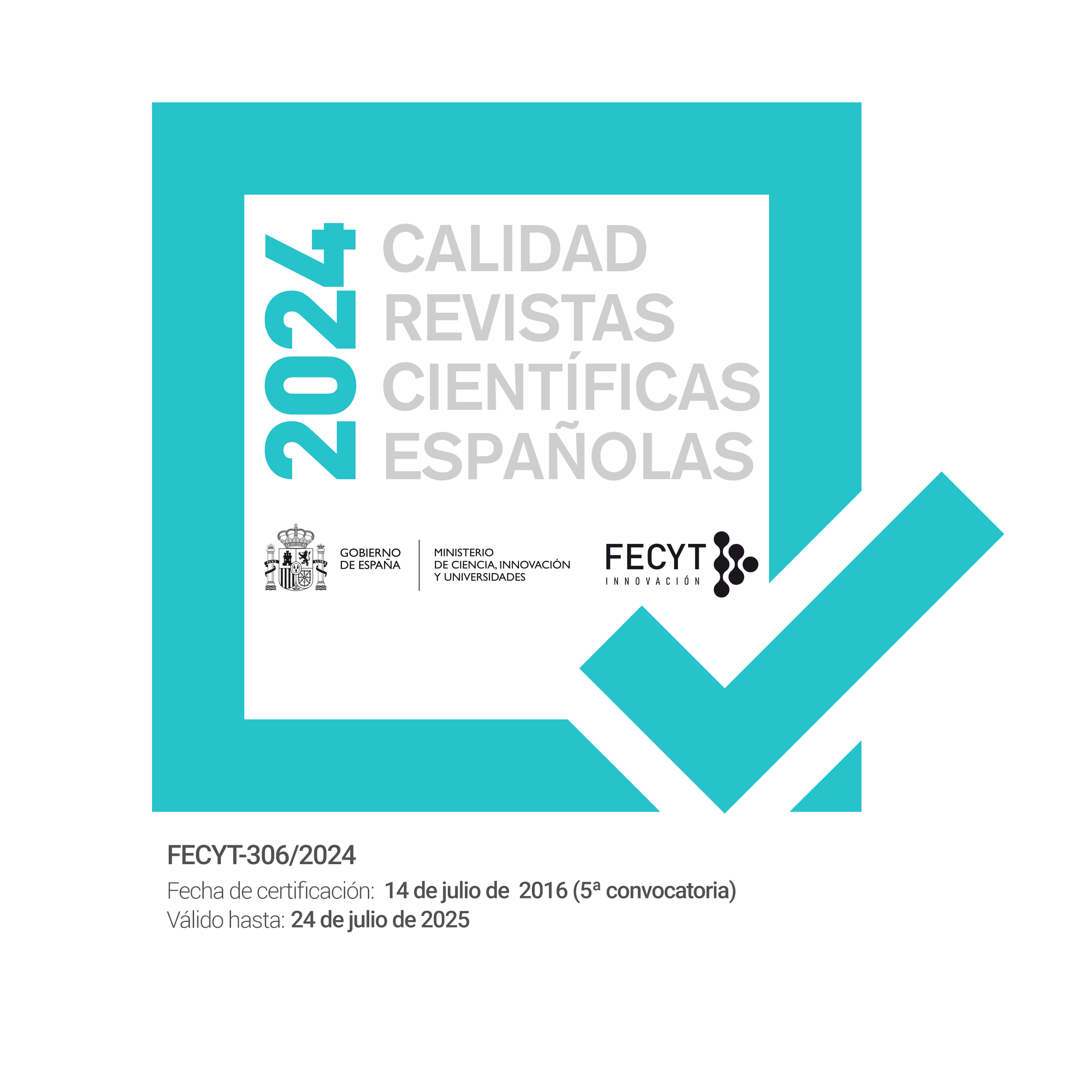La ambivalencia ante la innovación: representaciones sociales de los riesgos y beneficios de la innovación en la sociedad española
DOI:
https://doi.org/10.22325/fes/res.2019.30Palabras clave:
innovación, ambivalencia, riesgos y beneficios, percepción pública, encuestas socialesResumen
Los estudios de innovación han prestado poca atención a la percepción pública o significados de la innovación. Este artículo realiza una contribución a la sociología de la innovación utilizando el concepto de ambivalencia. El objetivo principal es indagar los riesgos y los beneficios asociados a la innovación. Los datos utilizados se basan en una encuesta personal cara a cara representativa de la población española. Las percepciones sobre riesgos y beneficios se utilizan para elaborar una tipología de la diversidad de ideas y sentidos de la innovación mediante análisis factorial y de conglomerados. Además, se usan los conocimientos relacionados con la innovación y actitudes pro-innovadoras de los encuestados para entender cómo la percepción pública de la innovación está influida por factores sociales, económicos y culturales. El artículo permite observar cómo la ambivalencia es una clave central para entender el papel de la innovación en el imaginario colectivo.
Citas
Aitken, M. (2009). Wind Power Planning Controversies and the Construction of “Expert” and “Lay” Knowledges. Science as culture, 18(1), 47-64.
Arribas-Ayllon, M., Bartlett, A. (2014). Sociological ambivalence and the order of scientific knowl- edge. Sociology, 48(2), 335-351.
Asheim, B. T., Coenen, L. (2005). Knowledge bases and regional innovation systems: Comparing Nordic clusters. Research Policy, 34(8), 1173-1190.
Baek, Y. M. (2010). An integrative model of am- bivalence. The Social Science Journal, 47(3), 609-629.
Bauer, M. W. (2013). Los cambios en la cultura de la ciencia en España. 1989-2010. En FECYT (ed.), Percepción Social de la Ciencia y la Tecnología 2012 (pp. 191-226). Madrid: Fundación Española para la Ciencia Y la Tecnología (FECYT).
Beck, U. (2000). Risk Society revisited. En B. Adam, U. Beck, J. Van Loon (eds.), The risk society and beyond: critical issues for social theory (pp. 211-229). New Delhi: Sage.
Binder, A. R., Cacciatore, M. A., Scheufele, D. A., Shaw, B. R., Corley, E. A. (2012). Measuring risk/benefit perceptions of emerging technologies and their potential impact on communication of public opinion toward science. Public Understanding of Science, 21(7), 830-847.
Boltanski, L., Chiapello, E. (2002). El nuevo espíritu del capitalismo. Madrid: Ediciones Akal.
Connor, M., Siegrist, M. (2013). Sorting biotechnol- ogy applications: Results of multidimensional scaling (MDS) and cluster analysis. Public Understanding of Science, 22(2), 128-136.
Durant, D. (2008). Accounting for expertise: Wynne and the autonomy of the lay public actor. Public Understanding of Science, 17(1), 5-20.
Edquist, C. (2005). Systems of Innovation: Perspectives and Challenges. En J. Fagerberg, D. C. Mowery, R. R. Nelson (eds.), The Oxford hand- book of innovation (pp. 181-208). Oxford: Ox- ford University Press.
Felt, U., Fochler, M. (2011). Slim Futures and the Fat Pill: Civic Imaginations of Innovation and Governance in an Engagement Setting. Science as culture, 20(3), 307-328.
Fischer, A. R., van Dijk, H., de Jonge, J., Rowe, G., Frewer, L. J. (2013). Attitudes and attitudinal ambivalence change towards nanotechnology applied to food production. Public Understanding of Science, 22(7), 817-831.
Fligstein, N. (2002). The architecture of markets: An economic sociology of twenty-first-century capitalist societies. Princeton: Princeton University Press.
Godin, B. (2015). Innovation contested. The idea of Innovation over the Centuries. New York: Routledge . Hofstede, G., Minkov, M. (2013). VSM 2013 (en lí- nea). https://geerthofstede.com/wp-content/ uploads/2016/07/Manual-VSM-2013.pdf, acceso: 30 de septiembre de 2015.
Howaldt, J., Schwarz, M. (2010). Social Innovation: Concepts, research fields and international trends. Dortmund: Sozialforschungsstelle Dortmund.
Kastenhofer, K. (2009). Debating the risks and ethics of emerging technosciences. Innovation. The European Journal of Social Science Re- search, 22(1), 77-103.
Kotchetkova, I., Evans, R., Langer, S. (2008). Articulating Contextualized Knowledge: Focus Groups and/as Public Participation? Science as Culture, 17(1), 71-84.
Lamo, E., González, J. M., Torres, C. (1994). La sociología del conocimiento y de la ciencia. Madrid: Alianza Editorial.
Luján, J. L., Todt, O. (2000). Perceptions, attitudes and ethical valuations: the ambivalence of the public image of biotechnology in Spain. Public Understanding of Science, 9(4), 383-392.
Malerba, F. (2002). Sectoral systems of innovation and production. Research Policy, 31(2), 247-264.
Marks, N. J. (2011). Stem cell researchers’ trust, ambivalence and reflexivity: opportunities for improved science-public relations? Science and Public Policy, 38(7), 541-554.
Marques, M. D., Critchley, C. R., Walshe, J. (2015). Attitudes to genetically modified food over time: How trust in organizations and the media cycle predict support. Public Understanding of Science, 24(5), 601-618.
McNeil, M. (2013). Between a Rock and a Hard Place: The Deficit Model, the Diffusion Model and Publics in STS. Science as culture, 22(4), 589-608.
Merton, R. K., Muñoz, J. L. L. (1980). Ambivalencia sociológica y otros ensayos. Madrid: Espasa- Calpe.
Molina, Ó. M., De los Monteros, E. (2010). Rotación en análisis de componentes principales categórico: un caso práctico. Metodología de en- cuestas, 12(1), 63-88.
Muñoz, A. (2013). Diez años de encuestas de percepción social de la ciencia y la tecnología en España: ¿ha cambiado la actitud de la población? En FECYT (ed.), Percepción Social de la Ciencia y la Tecnología 2012 (pp. 257-292). Madrid: Fundación Española para la Ciencia Y la Tecnología (FECYT).
Nelson, R. R. (1993). National innovation systems: a comparative analysis. Oxford: Oxford university press.
OECD (2010). Taxation, Innovation and the Environment. Paris: OECD Publishing.
OECD (2018). OECD Due Diligence Guidance For Responsible Business Conduct (en linea). http:// mneguidelines.oecd.org/, acceso: 1 de diciembre de 2018.
Pestre, D. (2008). Challenges for the democratic management of technoscience: governance, participation and the political today. Science as culture, 17(2), 101-119.
Phills, J. A., Deiglmeier, K., Miller, D. T. (2008). Re- discovering social innovation. Stanford Social Innovation Review, 6(4), 34-43.
Ramella, F. (2015). Sociology of economic innovation (Vol. 154). New York: Routledge.
Roberts, M. R., Reid, G., Schroeder, M., Norris, S. P. (2013). Causal or spurious? The relationship of knowledge and attitudes to trust in science and technology. Public Understanding of Science, 22(5), 624-641.
Robles, F. (2000). La ambivalencia como categoría sociológica en Simmel. Reis, 219-235.
Rogers, E. M. (1995). Diffusion of innovations. New York: Free Press.
Schumpeter, J. A. (1957). Teoría del desenvolvimiento económico: una investigación sobre ganancias, capital, crédito, interés y ciclo económico. México D. F.: Fondo de Cultura Económica.
Soskice, D. W., Hall, P. A. (2001). Varieties of capitalism: The institutional foundations of comparative advantage. Oxford: Oxford University Press..
Stephan, U., Uhlaner, L. M. (2010). Performance- based vs socially supportive culture: A cross- national study of descriptive norms and entrepreneurship. Journal of International Business Studies, 41(8), 1347-1364.
Takahashi, B., Tandoc Jr, E. C. (2016). Media sources, credibility, and perceptions of science: Learning about how people learn about science. Public Understanding of Science, 25(6), 674-690.
Thorpe, C., Gregory, J. (2010). Producing the post- Fordist public: The political economy of public engagement with science. Science as culture, 19(3), 273-301.
Torres, C. (2005). La ambivalencia ante la ciencia y la tecnología. Revista Internacional de Sociología, 63(42), 9-38.
Torres, C., Lobera, J. (2015). Representaciones sociales y resistencia a la ciencia y la tecnología en la opinión pública. En FECYT (ed.), Percepción Social de la Ciencia y la Tecnología 2014 (pp. 131-164). Madrid: Fundación Española para la Ciencia Y la Tecnología (FECYT).
Von Hippel, E. (2005). Democratizing innovation.
Cambridge, MA: MIT Press.
Descargas
Publicado
Cómo citar
Número
Sección
Licencia
Todas las publicaciones de la Revista Española de Sociología se realizarán bajo una licencia abierta Creative Commons de Reconocimiento 4.0 Internacional (CC BY 4.0). Dicha licencia establece que los autores son los poseedores de los derechos de propiedad intelectual de sus trabajos, que pueden redistribuirse a cambio de un reconocimiento adecuado. Para más información de la licencia Creative Commons, consultar aquí.
Una vez aceptado un artículo para su publicación, la Revista Española de Sociología solicitará al denominado "autor para la correspondencia" la aceptación de una licencia obligatoria Creative Commons incluida en un acuerdo o contrato de publicación.



